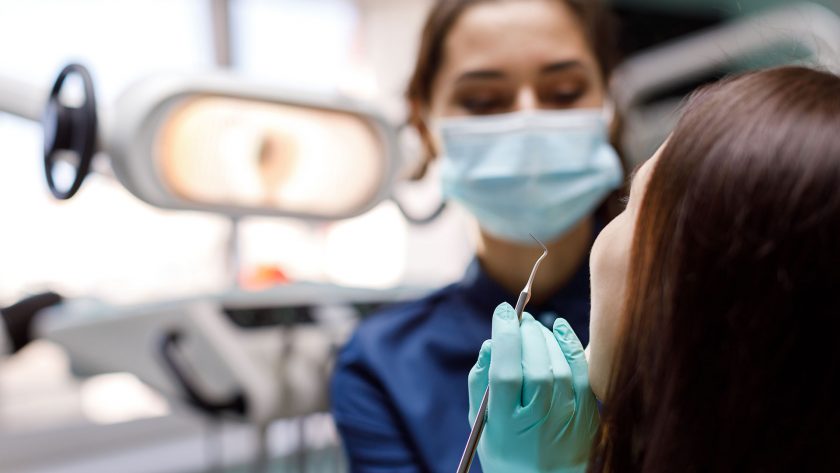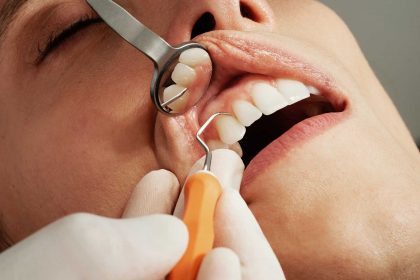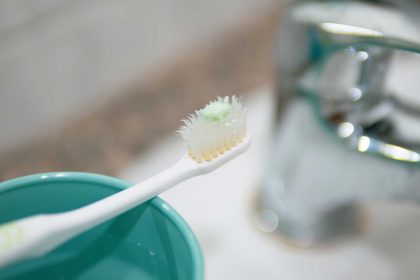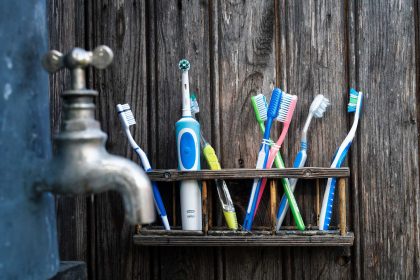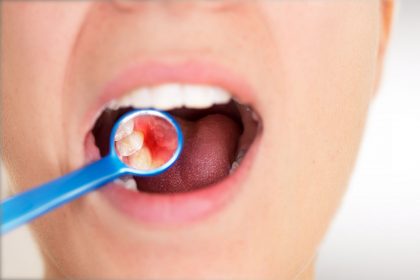Tooth decay is one of the most common diseases in the world. An estimated 90% of Americans have had at least one cavity by the time they reach their mid 20s, and more than one in four adults currently have untreated cavities. But where do cavities come from?
Cavities form when plaque and tarter build up on the surface of teeth. Bacteria living in this tartar feed on sugary or starchy foods and then release acid onto the tooth’s enamel. This acid strips away vital minerals from the tooth, eventually creating a hole or cavity.
While the acid from this bacteria is the ultimate villain when it comes to cavity formation, we should also consider the underlying conditions that allow the bacteria to thrive. Among other things, oral hygiene and diet are big factors.
But before we get into that, we need to understand a bit about the structure of the tooth and the environment inside the mouth.
The anatomy of a tooth
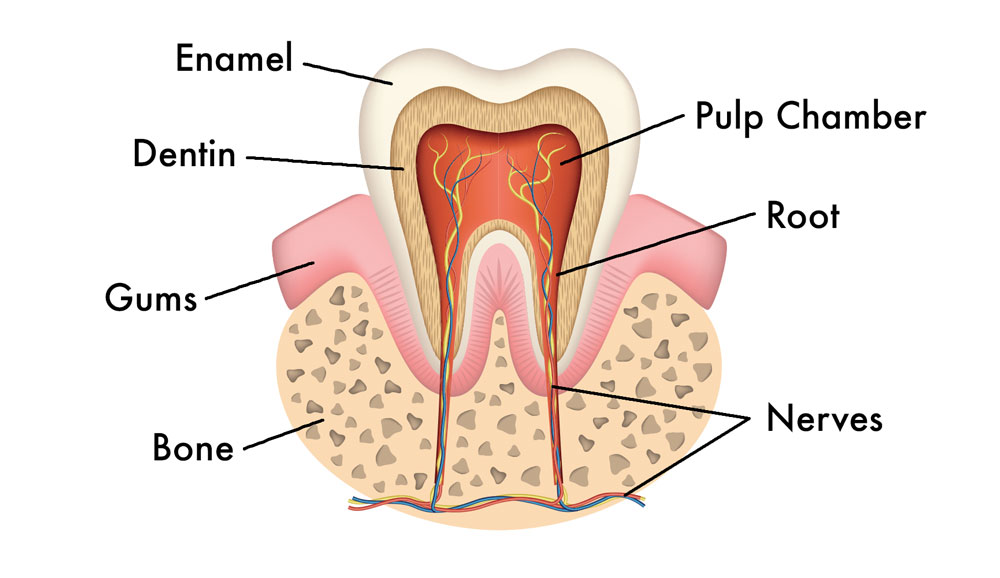
A tooth consists of its crown, which is the part of the tooth visible in and above the gums, and the root, which anchors the tooth within the bone below.
The hard, white outer surface of the tooth is the enamel. The enamel is composed of crystalline calcium phosphate, a non-living, mineralized substance.
The next layer inside the tooth, protected by the enamel, is the dentin. The dentin is living tissue with a structure similar to bone.
The pulp chamber and the root canal are the innermost parts of the tooth. This is soft tissue containing blood vessels and nerves. Nutrients and white blood cells supplied through this soft tissue help to fight bacteria and keep the tooth alive and strong.
The gums (aka the gingiva) are the soft tissue that covers and protects the jawbone and the roots of the teeth.
The environment inside the mouth
The mouth is a warm, moist place with lots of nooks and crannies and ridges and soft tissues. It’s the perfect place for bacteria to thrive — and thrive they do.
While some of this bacteria is harmful to our teeth — Streptococcus mutans and Porphyromonas gingivalis, we’re looking at you — other bacteria are actually helpful because of the way they keep the harmful ones in check.
There are over 700 known species of bacteria that reside in the human mouth, and there’s nothing we can do about it.
The other important element inside your mouth is your saliva, which helps with digestion, protection against harmful bacteria, and remineralization.
What is remineralization?
Tooth remineralization is a natural process in which calcium and phosphate from saliva are absorbed into the enamel of the teeth, replacing the minerals that have been stripped away by acidity.
Cavities form when demineralization occurs faster than remineralization
It’s like a battle inside your mouth:
- On one side you have harmful bacteria supported by sugary and starchy foods. This bacteria resides in plaque, that sticky biofilm that you sometimes feel coating your teeth. When the bacteria breaks down the starches and sugars, acid is released onto a tooth’s enamel. This acid strips away minerals from the teeth. Plaque can harden into tartar, making the bacteria more difficult to remove.
- On the other side are saliva and the minerals that rebuild the enamel, including calcium, phosphate, and sometimes fluoride.
In a healthy mouth, these two sides are in balance. Teeth are remineralized as quickly as they are demineralized.
In an unhealthy mouth, though, the harmful bacteria have taken the lead. They have formed hardened zones of tartar on the teeth and are thriving in an acidic environment, feeding on sticky, starchy bits of leftover lunch. Your teeth are losing minerals faster than they can be replaced.
All cavities start the same way — and then get worse
Repeated acid attacks that overwhelm the pace of remineralization will result in cavities. They will start as white spots on the teeth — whiter than the surrounding enamel.
These white spots are a warning sign that demineralization has begun, but at this point it’s not too late to reverse the process if you follow these steps:
- Practice excellent oral health habits.
- Cut back on those sugary foods.
- And for added certainty schedule a visit to a dentist. Your dentist can provide fluoride treatments, sealants, or even a calcium/phosphate/protein cream to encourage remineralization. These are easy, pain-free treatments, no needles or drills required.
If you’ve waited too long and the white spots have turned to dark spots, that means the enamel has eroded away beneath the surface. You have a cavity in your tooth. Schedule a visit with your dentist now.
If you wait even longer, the cavity will reach the dentin, the bony substance within the tooth. You’ll start to feel some pain at this point. Schedule a visit with your dentist NOW.
If you wait even longer, the cavity will reach the pulp of the tooth. Remember that place where the nerves live? Yeah, you’re feeling it now, aren’t you? Your dentist is probably telling you that you need a root canal, and you’re wishing you’d made this appointment a long time ago.
We don’t even want to talk about what happens if you let this go to an abscess. We’ll save that for another day.
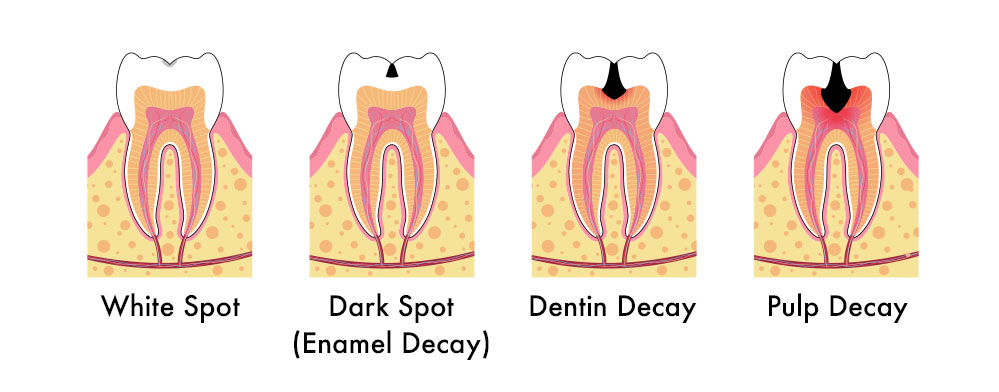
So once again, what causes cavities in teeth?
We’ve covered all the technical details: the bacteria, the acid, the demineralization. But all of that is really just a side effect of poor oral hygiene. What causes cavities for the most part is having a filthy mouth.
The best way to prevent cavities is pretty simple:
- Brush your teeth soon after every meal.
- Floss once a day.
- A pulsing oral irrigator (aka a water flosser) can seem almost magical in the way it removes particles of food from beneath the gums even after brushing and flossing.
- Cut way back on those starchy, sugary foods.
- Visit your dentist regularly for checkups and get professional teeth cleaning as often as your dentist recommends.
Do children and older adults need special protection against cavities?
Dental sealants to protect against cavities are great for children when their permanent molars and premolars come in.
Older adult teeth have suffered a lifetime of wear and tear. Older adults also often take medications that limit saliva production, which puts their teeth at greater risk. So extra care should be taken to keep the mouth clean, and regular dental visits are more important than ever to prevent cavities.
Are there other conditions that might lead to cavities?
Anything that throws off the balance of demineralization and remineralization can be an influence on the formation of cavities. Dry mouth, for example, decreases remineralization by decreasing saliva production. Acid reflux increases demineralization by increasing the acid in your mouth. Other conditions that can make you more cavity prone include eating disorders, diabetes, arthritis, heart disease, and certain medications that you might be taking. Be aware of any factors that might put you at increased risk, and never drop your guard when it comes to oral hygiene.
